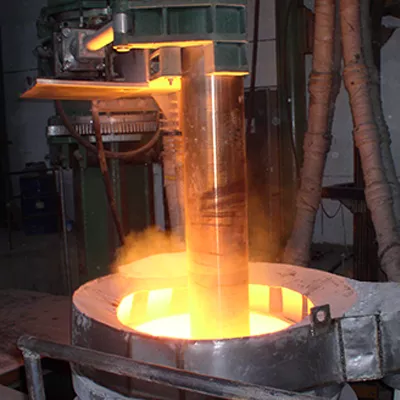1. Preparation before smelting:
Batch:
Use high-quality profile scraps or refined continuous casting bars with the same or similar composition as the required steel grade as the main material. Generally, the amount of recycled materials should be controlled within 30%. For castings with high quality requirements, recycled materials are not used. The amount of ferroalloy used to adjust the composition does not exceed 5%; accurately weigh the furnace materials according to the batching list and record them.
Requirements for furnace materials:
All metal furnace materials must be clean, free of rust, oil, dry and moisture. There is no residual shell material after shot blasting of recycled materials. Electrolytic metals such as electrolytic nickel need to be dehydrogenated by baking at 800℃. Other ferroalloys added during smelting need to be weighed and placed in an oven ≧100℃ for standby; slag-making agents lime and fluorite should be placed in the oven for standby to prevent moisture absorption; slag removers should be screened to remove ash and dried at low temperature and placed in front of the furnace for standby.
Charging:
First, add 80–90% dry lime and 10–20% fluorite as slag-maker to form bottom slag. This contacts molten steel early and covers it during melting. Use 1–2% slag-maker by charge weight to fully cover the molten steel. Place fine steel at the furnace bottom, then add refractory, non-oxidizing alloys like ferromolybdenum, ferrotungsten, and nickel. Add other alloys after pre-deoxidation. Load main materials vertically and tightly for easy downward movement during melting.
The induction furnace has a large depth-to-diameter ratio and heats metal via electromagnetic induction. Its thin wall improves electrical efficiency but reduces contact with the slag layer. Molten steel transfers heat to slag, keeping slag temperature low. The thin furnace wall cannot withstand transitional impact. Therefore, induction furnaces cannot smelt steel, only rapidly remelt qualified metals. Therefore, the charge must be accurate and clean in composition.
Alkaline linings should be made into alkaline slag. The oxides in the charge react with the slag first, so as not to pollute and adhere to the lining. Unless the charge is very clean, there is no need to make slag.
2. Rapid melting
After charging, start full power to speed melting and reduce oxidation and air absorption. For cold furnaces with magnesia lining, start with low power due to lining cracks. Heat the steel slowly until the lining turns red and cracks are healed. Then switch to full power for rapid melting. Add and push charge in time during melting to maintain efficiency. The return charge of various shapes is easy to get stuck, so it can be added at the end. It is necessary to prevent the “bridging” accident caused by improper charging or untimely pushing.
During operation, it is necessary to pay attention to make the slag layer cover the molten steel well. If the amount of slag is too little, slag-making agent can be added to prevent the molten steel from being exposed. If the slag layer is too thick, part of the slag can be skimmed off. Since the single slag method is adopted, the slag should not be replaced in the middle.
During melting in a non-vacuum furnace, steel is constantly oxidized by oxygen in the air. Both solid and molten steel are affected during the heating process. Electromagnetic stirring prevents slag from covering early molten steel. Only after most steel melts can slag cover the surface. The slag then isolates the molten steel from air exposure.
In order to reduce the oxidation of steel during the melting process, there are two commonly used measures:
① Increase the power supply and shorten the melting time, that is, shorten the time the steel is in contact with oxygen.
②Install an argon (nitrogen) gas protection device at the furnace mouth, open the inert gas protection device during the melting period of the steel material, drive away the air above the furnace mouth, form an inert gas protection layer, and close it when the molten steel is completely covered by the slag layer.
3. Adjust the composition and temperature increase
After pre-deoxidation, the molten steel is sampled immediately for spectral analysis. At this time, the power supply is lowered to the insulation power. According to the analysis results, the preheated alloy is added. When the molten steel composition is qualified, it is immediately heated up quickly at full power to reach the highest melting temperature and measured with an inserted thermocouple. The highest melting temperature should be determined according to different steel grades, such as 304 stainless steel is generally 1680~1700℃.
After pre-deoxidation, the oxygen content in the molten steel is reduced. At this time, various element alloys that are relatively easy to oxidize are added to the furnace, which has less oxidation loss and produces less oxidized inclusions. This period is a key period to ensure the qualified chemical composition of the steel by adding alloys and rapid analysis before the furnace.
4. Power-off and standstill
After the qualified molten steel reaches the highest melting temperature, the power is immediately turned off and the electromagnetic stirring in the molten steel stops, which is conducive to the oxides suspended in the molten steel produced after pre-deoxidation to float into the slag layer. For an induction furnace with a capacity of 100-150kg, the power-off standstill time is generally controlled at 2-3 minutes. As the power is turned off, the temperature of the molten steel begins to drop. When the temperature is too low, the viscosity of the molten steel increases and inclusions are not easy to float out.
Therefore, too long a standstill time has no effect. If there are too many inclusions in the steel, the temperature can be raised to the highest melting temperature again, and then a second power-off standstill is performed. During the power-off standstill period, the molten steel should be strictly covered, and the furnace mouth surface can also be covered with aluminum silicate fiber cotton.

